Spiraling-Up: Mapping Community Transformation with Community ...
Spiraling-Up: Mapping Community Transformation with Community ...
Spiraling-Up: Mapping Community Transformation with Community ...
You also want an ePaper? Increase the reach of your titles
YUMPU automatically turns print PDFs into web optimized ePapers that Google loves.
COMMUNITY DEVELOPMENT: Journal of the <strong>Community</strong> Development Society, Vol. 37, No. 1, Spring 2006<strong>Spiraling</strong>-<strong>Up</strong>: <strong>Mapping</strong> <strong>Community</strong> <strong>Transformation</strong> <strong>with</strong><strong>Community</strong> Capitals FrameworkMary Emery and Cornelia FloraThis paper uses the <strong>Community</strong> Capitals Framework (CCF) to look at community change froma systems perspective. We find that social capital—both bonding and bridging—is the criticalresource that reversed the downward spiral of loss to an upward spiral of hope—a process we call“spiraling-up.” Focusing on the example of a change process implemented in Nebraska, HomeTownCompetitiveness, we delineate the assets invested, created, and expanded by the project. We alsoapply the CCF to understanding the flow among the capitals and the impact of this flow on communitycapacity to initiate and sustain a process of change, particularly in building social capital.Keywords: social capital, <strong>Community</strong> Capitals Framework, spiraling-up, rural developmentSocial capital is a critical community characteristic. It can influence, as well as beinfluenced by, the stock and flows of other capitals. By examining the interaction amongcommunity capitals, as well as the investment from the outside in different capitals, wecan better understand the critical role of social capital. By analyzing one case of suchinvestments in the context of creating a new system of positive community change, weillustrate how identifying community capitals and strategically increasing capitals stocksresulted in a spiraling up of those capitals as they begin building on one another. Weapply the <strong>Community</strong> Capitals Framework (CCF) to analyze a comprehensive communitydevelopment effort, the HomeTown Competitiveness program. Using field data andinterviews, we follow how capital investments were made and <strong>with</strong> what results.In July 2001, the National Rural Funders Collaborative (NRFC) widely distributed acall for collaborative strategic proposals to “reverse patterns of neglect and disinvestmentsin rural America.” The NRFC asked for collaborations of regional funders and at least twoorganizations or agencies to develop place-based strategies (as opposed to an individuallyorientedprogram) to reduce poverty in a specific rural region.The possibility of garnering $750,000 over a three-year period, coupled <strong>with</strong> increasedconcern for declines in rural population on the part of the state of Nebraska, brought togetherthree Nebraska-based not-for-profits to initiate formally HomeTown Competitiveness(HTC). Members of HTC focused on an integrated strategic approach to reverse thepopulation and per-capita income decline in rural communities on the Great Plains. Thus,they combined the strengths of the three groups: leadership development (HeartlandMary Emery is the Associate Director of the North Central Regional Center for Rural Development. She can bereached at 107 Curtiss Hall, Iowa State University, Ames, IA 50011. Phone: (515) 294-2878, E-mail: memery@iastate.edu. Cornelia Butler Flora is a Charles F. Curtiss Distinguished Professor of Agriculture and Sociology andthe Director of the North Central Regional Center for Rural Development. She can be reached at 108 Curtiss Hall,Iowa State University, Ames, IA 50011. Phone: (515) 294-1329, E-mail: cflora@iastate.edu. The authors wouldlike to thank the Editors for their help <strong>with</strong> this manuscript.© 2006, The <strong>Community</strong> Development Society19
COMMUNITY DEVELOPMENT: Journal of the <strong>Community</strong> Development SocietyCenter for <strong>Community</strong> Leadership Development), entrepreneurship development (RUPRICenter for Rural Entrepreneurship), and community foundations (Nebraska <strong>Community</strong>Foundation). Their focus on stemming youth out-migration meant that they looked forways to include youth in each of these groups.The three organizations had already created place-based strategies, and the leaders ofall three groups had roots in rural Nebraska. The leaders of the organizations had workedtogether informally and formally in different capacities for many years, and the missionstatements of the three organizations were compatible. They were well connected in thestate and the nation, having achieved individual reputations for effectiveness and integrity.The newly formed HTC thus had high levels of both bonding and bridging social capital asthey began to implement the integrated strategy (Emery, 2003).HTC was one of five collaboratives awarded a $50,000 learning partner grant in 2002,which was renewed for another year at $50,000 in 2003. The second grant allowed HTCto devote time and resources to support collaborative development and to integrate itsseparate strands: philanthropy to support entrepreneurship through strong local leadership.HTC formalized its four-part strategy: (1) to increase philanthropy by directing ruralwealth transfers to community foundations; (2) to retain youth in the community byincluding them in leadership, philanthropy, and entrepreneurship; (3) to increase leadershipcapacity through inclusive leadership development; and (4) to strengthen local economiesby identifying and building on local assets, particularly through intergeneration businesscontinuity and innovative business opportunities.The NRFC used the <strong>Community</strong> Capitals Framework (CCF) as an analytical tool todetermine the effectiveness of its investments in addressing structural conditions of ruralpoverty via capacity-building, leading to increased assets for rural families and communities,the transformation of rural leadership through expanded and inclusive leadership pools,and increased opportunities for families to attain self sufficiency. The NRFC used the CCFto analyze how community capitals were used in the transformative strategy.We looked at HTC’s approach by using the CCF to document how the strategy inone community reversed the spiral of decline that has gripped many rural communities.Decline in financial capital may trigger the downward spiral. The loss of an industry orvarious firms in a particular region makes it more difficult to mobilize political capital,which stimulates additional losses in human and social capitals in a vicious cycle of despair.The HTC approach sought to reverse this spiral through a series of public and privateinterventions we call “spiraling-up.” In this paper, we analyze one of the first communities,Valley County, Nebraska, in which HTC officially worked to show the degree to whichHTC’s integrated, collaborative strategy effectively and systematically increased all thecommunity capitals in a mutually-reinforcing spiral of community development. Throughthis spiraling up process, we identify critical investments in social capital as the entry pointfor community change.<strong>Community</strong> Capitals FrameworkThe <strong>Community</strong> Capitals Framework (CCF) offers a way to analyze community andeconomic development efforts from a systems perspective by identifying the assets in eachcapital (stock), the types of capital invested (flow), the interaction among the capitals,and the resulting impacts across capitals. The NRFC analysis includes indicators of sevendifferent components of community capital: natural, cultural, human, social, political,financial, and built capitals. The NRFC chose this approach because of its emphasis onassets (rather than needs or deficits) and its focus on investments (see Figure 1).1. Natural capital refers to those assets that abide in a particular location, includingweather, geographic isolation, natural resources, amenities, and natural beauty.20
Emery and FloraNatural capital shapes the cultural capital connected to place (Pretty, 1998;Constanza, et al., 1997).2. Cultural capital reflects the way people “know the world” and how they act <strong>with</strong>in it,as well as their traditions and language. Cultural capital influences what voices areheard and listened to, which voices have influence in what areas, and how creativity,innovation, and influence emerge and are nurtured. Hegemony privileges the culturalcapital of dominant groups (Bourdieu, 1986; Flora et al., 2004; Bebbington, 1999).3. Human capital is understood to include the skills and abilities of people to developand enhance their resources and to access outside resources and bodies of knowledgein order to increase their understanding, identify promising practices, and to accessdata for community-building. Human capital addresses the leadership’s ability to“lead across differences,” to focus on assets, to be inclusive and participatory, andto act proactively in shaping the future of the community or group (Becker, 1964;Flora et al., 2004).4. Social capital reflects the connections among people and organizations or the social“glue” to make things, positive or negative, happen. Bonding social capital refers tothose close redundant ties that build community cohesion. Bridging social capitalinvolves loose ties that bridge among organizations and communities (Narayan,1999; Granovetter, 1973 & 1985). A specific configuration of social capital—entrepreneurial social capita1 (ESI)—is related to community economic development(Flora & Flora, 1993; Flora et al., 1997). ESI includes inclusive internal and externalnetworks, local mobilization of resources, and willingness to consider alternativeways of reaching goals.5. Political capital reflects access to power, organizations, connection to resources andpower brokers (Flora et al., 2004). Political capital also refers to the ability of peopleto find their own voice and to engage in actions that contribute to the well being oftheir community (Aigner et al., 2001).6. Financial capital refers to the financial resources available to invest in communitycapacity-building, to underwrite the development of businesses, to support civicand social entrepreneurship, and to accumulate wealth for future communitydevelopment (Lorenz, 1999).7. Built capital, finally, includes the infrastructure supporting these activities (Flora etal., 2004).Figure 1. <strong>Community</strong> CapitalsBuiltCapitalFinancialCapitalNaturalCapitalPoliticalCapitalCulturalCapitalSocialCapitalHumanCapital21
COMMUNITY DEVELOPMENT: Journal of the <strong>Community</strong> Development SocietyIn applying the CCF to HTC, we thought to demonstrate increased capacity by showingthat a project’s strategies invested assets from vital areas (human, social, and financialcapital) resulting in increased assets among those capitals as well as others. Others usingthe CCF had determined that the increase in specific assets, while helpful to the community,might not have an impact on overall capacity. Guiterrez-Montez (2005) found that the flowof assets across capitals—that is, human capital invested in a project leading to increasesin the stock of assets in financial, political, cultural, and social capital—can initiate anongoing process of assets building on assets, leading to the effect of an upward spiral. Or,as many have observed, “success builds on success.” Our study of HTC in Valley Countyprovides additional support for the notion that capacity cannot be measured merely byincreases in stocks of assets <strong>with</strong>in the specific capitals, but requires an increase in the flowof assets that build stock in additional capitals. As we mapped the strategies connectedto HTC, we observed examples of processes and strategies that led to increases in assetsacross the capitals (see Figure 2).Figure 2. The <strong>Spiraling</strong> of Capital Assets<strong>Spiraling</strong> downLoss of jobsDecline in populationDecline in percapital incomePhilanthropyprovides ongoingfunding tosupport moreleadership, newbusinesses, andrecruitment ofyouthCultural capitalincreasesInvolvement of youth,supportingentreperneurship,capturing 10% ofwealth transfer<strong>Spiraling</strong> upLoss ofgenerationaltransfer of wealthBridging socialcapital bringsoutside expertisetogether <strong>with</strong>internal wisdomIn the spiral-down period, the community declined in all capitals, resulting in a lossof hope and direction. Both human capital and financial capital decreased, as fewer peoplewere able to make a living on increasingly large farms. Young people left the county,decreasing social capital and creating a culture of despair and resignation. Political capitalwas reduced to reliance on commodity programs and lobbying through farm organizationsfor increased price supports. The infrastructure deteriorated. This situation correspondsto the theory of cumulative causation. Gunnar Myrdal (1957) formulated this theory thatstates: “The place that loses assets, for whatever reason, will continue to lose them throughsystem effects.” Additionally, the place that, for whatever reason, gains assets will attractother assets, which helps explain why there is an increasing inequality that is place-based.“<strong>Spiraling</strong>-up” represents a process by which assets gained increase the likelihoodthat other assets will also be gained (Gutierrez, 2005). In our model using community22
Emery and Floracapitals, as one capital is increased, it is easier for increases, instead of declines, in the othercommunity capitals to occur. However, the usual rural development strategy of beginning<strong>with</strong> infusions of financial capital or built capital is often not cumulative. <strong>Spiraling</strong>-upreverses declines in assets through a similar cumulative causation process in which assetgrowth becomes a self-reinforcing cycle of increasing opportunity and community wellbeing. Our research looked at the spiraling-up period, and how cumulative causation helpedto explain how increase in one capital can lead to increases in the others. Our contention isthat the best entry point to spiraling-up is social capital.METHODOLOGYWe collected data to analyze community capitals based on interviews <strong>with</strong> communityleaders in 2003 and 2004, <strong>with</strong> HTC partners in 2003 and 2004, from project partnerWebsites and reports, and from participant observations in July 2003. In addition, projectpartners reviewed an earlier version of this paper and provided feedback.In 2000, Valley County, Nebraska, had a population of 4,647, a 10% decline since1990. Ord, the county seat and commercial center, had a 2000 population of 2,269. Typicalof rural counties in the Great Plains, the population was aging rapidly, <strong>with</strong> high outmigrationof young people.Valley County’s labor force of 2,440, according to 2002 state employmentreports, experienced only a 2.6% unemployment rate, masking a serious problem ofunderemployment. The county, however, was also home to high number of self-employedpeople and small business owners, including ranchers, farmers, and shopkeepers.Manufacturing was limited, and government, both medical and educational, was—andcontinues to be—among the largest employers.In the late 1990s, the County Commission passed a resolution to fund the ValleyCounty Economic Development Council (VCEDC) and to hire a professional staff personto manage its efforts and to staff the Chamber. Determination, good intentions, and money,however, were not enough to turn around decades of decline. The leadership of ValleyCounty realized they needed help to identify how best to use their limited resources forthe most strategic outcomes. When offered the invitation to join the Collaborative fundedby the National Rural Funders Collaborative (NRFC) and to implement HTC’s integratedstrategy, they welcomed the opportunity. Since 2002, the newly-created collaborative ofcommunity and economic development practitioners and leaders in Valley County (HTCteam) has worked together proactively to shape a future that not only mitigates the effectsof their current economic situation, but also reaches out to reshape a “landscape of loss”(Nothdruft, 2002) into one of “opportunity” compatible <strong>with</strong> the region’s assets.Implementing HTC in Valley County, NebraskaThe HTC approach began <strong>with</strong> an assessment process developed in cooperation<strong>with</strong> community leaders. Recognizing the dearth of local resources available to ruralcommunities, the collaborative worked <strong>with</strong> community leaders to identify specificallytargeted strategies that emerged from the assessment process related to leadershipdevelopment, entrepreneurship, youth, and wealth transfer. When undertaken in unison,the strategies created a an upward spiral of growing assets across capitals that reversedthe downward spiral of declining assets found in many distressed rural community. Thisapproach required commitment to an intentional and focused use of scarce resources thatbecame strategic in the force, depth, and breadth of their impact as indicated by changesin the various capitals. The place-based focus of the approach allowed each community tochoose the strategies that best utilized their strengths (investing their assets) in addressingopportunities to transform their landscape into opportunity.23
COMMUNITY DEVELOPMENT: Journal of the <strong>Community</strong> Development Society<strong>Community</strong> leaders focused on the flight of young people, agreeing that it was notjust the call of the city that compelled them to migrate; it is also the lack of opportunitythat drove them away. The Center for Rural Entrepreneurship developed a formula thatadvocates how small towns can design efforts to halt this trend. Using existing data onpopulation change, Valley County calculated that it needed to retain or encourage the returnof three high school graduates per year to stop the overall population decline, a realistictarget for action (Emery et al., 2004).Based on this assessment, community leaders decided on several strategies. To mobilizecommunity members to work for a new future, they began a leadership development programthat included students from the high school and created task forces around each of the mainstrategies. Although Valley County had a small group of dedicated residents committed to“making a difference,” all agreed that leadership development was their greatest challenge.Two years into the project, interviews <strong>with</strong> important leaders indicated that they still identifiedleadership as the most critical element for success (Emery, 2003). Working to increase thenumber of people committed to building a new future for Valley County, as well as their skillsto do so effectively, was the cornerstone upon which other strategies depended.Each of the three strategies used in Valley County included a “youth” component. Thelocal HTC leadership team looked for opportunities to include young people; the local HTCentrepreneurship team found ways to help young people gain experience as entrepreneurs andto see entrepreneurship as a viable choice for a career; and the local HTC wealth transfer teamrecruited youth volunteers. Local leaders, however, saw a further need to develop a youthteam to coordinate the youth-related activities and to launch a “youth initiative.” This teamworked on strategies to attract young professionals to the community to work in expandingbusinesses or to take over firms whose owners were ready to retire.Using data developed on the wealth transfer predicted in Valley County, the Nebraska<strong>Community</strong> Foundation developed a reasonable target for capturing 5% of this transferredwealth, or $6,470,000 between 2002 and 2010, into a community foundation capable offunding future community and economic development efforts (Nebraska <strong>Community</strong>Foundation, 2004).Finally, many rural communities invested resources in economic development, but lackeda strategic plan for investing those resources to create viable employment opportunities andto develop businesses. Using strategies developed by the Center for Rural Entrepreneurship 1and the results of a business survey, the VCEDC directed its energies to support two specificgroups: (1) the inter-generational transfer of small businesses, particularly those on MainStreet and (2) companies <strong>with</strong> the potential to “break-through” to a broader product line ora larger market and to grow new jobs rapidly. Prior to this intervention, the VCEDC had astrategic plan detailing over 20 specific economic development goals, but it lacked a methodto determine the value of its investment in any one goal.Together, these strategies provided VCEDC <strong>with</strong> specific attainable goals allowingit to target its scarce resources for maximum effect. Its leaders felt that together, thesestrategies addressed the root causes of rural decline and offered the community a way towork toward a healthy and sustainable future.Implementing HTC in Valley County: Strategy Implementation andResultsThe HTC strategy had found fertile ground in Valley County. Previously, ValleyCounty had passed a local option tax that committed resources and personnel to createnew jobs and protect existing businesses. Earlier, the Nebraska <strong>Community</strong> Foundationhad begun work in the area by forming the Valley County Foundation Fund. These efforts,together <strong>with</strong> the following readiness factors (Emery, 2003), created an environment ready24
Emery and Florafor change. Leaders knew things had to change. Outside agencies coached local advocateson the threats and possibilities. Participants worked to set up “wealth capture” options andto identify internal resources to aid in that change<strong>Community</strong> Capitals Stocks and FlowsIn her study of the effect of forest fires on community assets, Gutierrez-Montes(2005) found that the downward spiral of decreasing assets <strong>with</strong>in the community hadan accumulative effect. The fire destroyed the environment, which led to decreasedemployment, which led to poverty and health problems, which began the destruction ofcultural and social capital <strong>with</strong>in the community, which led to a decline in maintainingroads and other infrastructure, etc. The downward spiral was reversed when the local peopleand outside consultants came together as equals to combine their knowledge and changethe direction of the spiral. The resultant actions led to an upward spiral of increasing assetsacross the capitals. Social capital played a similar role in the HTC project—bridging socialcapital facilitated mobilizing resources that increased the stocks of other capitals.We analyzed how each of the three HTC projects, which consisted of flows ofcapital through holistic community capacity-building, contributed to increased stocks ofcommunity capitals in Valley County. The changes in community capital that we measuredqualitatively and quantitatively were systematically sorted into the appropriate communitycapital, and we found that each of the three projects contributed to the spiraling up ofcommunity assets, and that the three projects not only stimulated the other projects, butalso reinforced them as well.Leadership and capacity buildingUsing a common process for community leadership development, the local HTCteam set up an eight-month program. Sixteen people, including four high school students,reserved one day each month to participate in a program to increase skills, create awarenessof leadership opportunities, and expand their understanding of the County.A second and third class was also well attended and generated similar evaluation results.The local leadership team worked to coordinate activities and information among communitygroups and to recognize the role of volunteers and local leaders (Emery, 2004b).We found that community leaders invested their assets in social capital, both bondingand bridging to recruit students and access human capital resources for instruction. Theyinvested local and partner assets in human and financial capital to offer the course. Theseinvestments led not only to increases in the capitals invested, but also to other capitals, thuscontributing to the spiraling-up process. Of particular importance, we saw changes in culturalcapital regarding community norms and values about participating in the community andsupporting local leaders. We observed the beginning of new assets in political capital asinterviewees reported that people outside the traditional leadership structure were findinga voice in community affairs.Leadership development and capacity-building undergirded the integrated HTC strategy.Without changes in the traditional leadership structure and actors, the community could nothave mobilized citizens to support changes. The collaborative partners provided technicalassistance and coaching that encouraged 35 people to graduate from two leadership classes.Buoyed by this success, the leadership team promised to offer the class each year. They willincrease the value of the program each year as they learn from their experiences. The teamwas dedicated to long-term development of community human capital. The involvementand support of youth was particularly important to the team’s sense of accomplishment. Theleadership team reported that more people increased their involvement in community groups,and the leadership core expanded somewhat to include new voices.25
COMMUNITY DEVELOPMENT: Journal of the <strong>Community</strong> Development SocietyThe impacts these leaders hoped to see in the future included developing a supportiveculture in which leaders no longer risk their businesses by running for office and in whichmany people from different walks of life participate in leadership roles. The leaders areworking <strong>with</strong> the Nebraska <strong>Community</strong> Foundation to look at ways the Foundation cansupport diversified leadership development through scholarships. Already, the communitysupported the involvement of more youth and adult-to-youth interaction. Leaders have alsoincreased their ability to interact <strong>with</strong> state and local government agencies, as well as <strong>with</strong>other agencies connected to their issues.The experience in Valley County has changed the behaviors of some institutions whosemanagement saw how local leaders succeeded in turning around long-term decline. Forexample, officials of the utility companies now provide financial resources to support the HTCprogram in Valley County and in other locations as well. The leadership team saw an emergingoutcome of the project in that more community members understand that each person can makea difference and a contribution to positive community change. By building on their own history,the team hoped to nurture a culture of working together for the good of the whole community.Indeed, the local leaders realized that the community was working to overcome historicalconflicts that prevented successful community capacity-building in the past.Local leaders recognized that more people were willing to run for office and participateas leaders in the community. In the 2004 election, all offices had at least two candidatesrunning, in contrast to previous elections when recruiting just one candidate to run foroffice was difficult. The experience in Valley County changed how people think about itsleaders, what they do, and how they do it. The leaders are making progress in including allgroups in the community, so all have a voice. A big success for them was the willingness ofa woman to run for county office. Finally, the ultimate success of this effort will be evidentin the long-term ability of local teams to generate and encourage o the recruitment of newleaders and increase participation <strong>with</strong>in the community leadership over the next decade.Capturing funds from the transfer of wealthHTC organized training for financial managers and attorneys to help people understandthe options available for estate planning. In addition, collaborating agencies coached thecommunity on revitalizing the community foundation, recruiting volunteers beginning amassive effort to promote community awareness. They attained their 5% goal in 2004, andset a goal of capturing 10% of calculated transfer of wealth by 2010.The primary inputs to the strategy to capture 5% of the wealth transfer involvedincreasing the human capital of financial planners, attorneys, and real estate professionalsto develop and to enhance skills in charitable giving. In addition, the human capital of thelocal foundation increased when members received training and coaching on how to ask forgifts and how to make giving back to the community an important part of everyday life inValley County. In addition, however, foundation members worked hard to make philanthropya community norm as measured by the percent of the population participating in giving.Consequentially, the Foundation learned techniques from other organizations andgroups on how to focus on giving strategically. That is, projects must be selected to buildlocal assets to achieve a sustainable future instead of selecting “band-aid” and “feel-good”projects. The leaders recognized the limitations of investing in projects like communityparks when, <strong>with</strong>out a change in direction, there would be few children to enjoy the parks.Developing indicators to measure the consequence of their investment was critical tosuccess. Recently, the foundation assisted twenty young professionals in moving to thecommunity (Stier, 2005).Finally, Valley County leaders are working on developing an umbrella foundationto organize giving campaigns and to share management expenses, thus formalizing the26
Emery and Floraemerging social capital focused on community giving. Under the umbrella foundation,community participation will be a strong indicator of how well the community has maturedbeyond previous conflict and generated value-added capacity for working together increating a sustainable and healthy community that will, in turn, increase stock in cultural,human, and social capital.The HTC team set a new goal of capturing 10% of the wealth transfer. Again,the role of bridging social capital is important in blending the outside expertise onwealth transfer <strong>with</strong> the local leaders and their knowledge of place. The investmentof social capital, human capital, and financial capital to support the launch of thisstrategy created an upward spiral across the capitals, in particular changes in culturalcapital that encourage people to give back to the community. Both human and socialcapitals expanded as more people became involved in the work either as volunteers oras donors. Long-term investment of local assets in achieving their wealth transfer goalwill provide financial capital to support self-development in perpetuity. Used wisely tosupport the community’s vision of the future, financial and cultural capitals can sustainthe upward spiral well into the future.Economic development and entrepreneurshipHTC worked <strong>with</strong> the VCEDC to prioritize several essential strategies, thus enabling thestaff to focus on those most likely to make a difference in the near future. Training local teammembers to conduct interviews <strong>with</strong> local businesses helped the team to identify several strongfirms <strong>with</strong> skills that they were willing to share <strong>with</strong> others to build their business developmentassets, thus expanding the human and social capital of the local team. These interviews aidedthe local team in identifying those businesses <strong>with</strong> high job growth potential and determininghow the team might best assist them in their growth. In the process of interviewing businessesand collecting data on other businesses, the team uncovered a pool of 25 businesses <strong>with</strong>some potential for fast growth or generational transfer. Targeting several businesses <strong>with</strong>the potential for inter-generational transfer not only helped the retiring generation preservethe assets they worked hard to develop, but also assisted <strong>with</strong> capital needs of the youngergeneration, related or otherwise, enabling the business to continue successfully as an assetfor the community. The team looked at the profile of business ownership in Valley County todetermine the best strategy for creating good jobs. By offering hands-on technical assistanceto these businesses, the VCEDC experienced an immediate return on its investment whileincreasing the visibility and importance of their efforts.To date, the local entrepreneurship team can show some outcomes <strong>with</strong> several businessesin terms of job creation and work toward successful business successions. The team workedto revive a local investment club to use its capital to support local business development.Finally, the team identified ways to encourage young people to see entrepreneurship aspositive career choice <strong>with</strong> growth potential in Valley County. A local person was hired as anentrepreneurship coach to benefit young people and existing businesses. In spring 2005, theHTC entrepreneurship coach worked <strong>with</strong> high school and middle school youth to developbusiness ventures that culminated in a business fair that netted thirty young entrepreneursover $4,000 in sales (Rural Electric Nebraskan, July 2005: 15).The HTC team hopes that the long-term impact of their work will result in a communitythat is supportive of entrepreneurial efforts and small but growing businesses. Additionally,HTC worked <strong>with</strong> the VCEDC to understand the notion of regional competitiveness better. 2The entrepreneurial coach’s portfolio of active business clients grew to over 100businesses. The excitement in the community about future opportunities helped it wina major investment by an ethanol plant from an outside business (Stier, 2005). Thecommunity’s success in business development and support are reflected in the growth27
COMMUNITY DEVELOPMENT: Journal of the <strong>Community</strong> Development Societyof local businesses and jobs and an increase in per capita income. To reach its goals, thecommunity eventually wants to work on a regional economic development approach thatsupports the development of business clusters and successful global marketing.Previously, local leaders sought to generate jobs through “industrial attraction” alone<strong>with</strong> little or no return on this investment after the initial success <strong>with</strong> the call center. ,Bridging social capital brought outside entrepreneurship development expertise, together<strong>with</strong> local volunteers and businesses, offering a new vision of the community’s potential.The processes continued to generate new bonding and bridging social capital as additionalentrepreneurs and volunteers joined in. Furthermore, all partners expanded their knowledgeof what interaction worked to create good jobs in rural America.HTC provided local leaders and the local entrepreneurship team <strong>with</strong> technicalassistance and coaching on how to work <strong>with</strong> local businesses thus increasing humancapital. The interviews <strong>with</strong> local business owners generated new social capital. Success ledto increased cultural capital as the community became more supportive of entrepreneurialefforts and local businesses. The growth in businesses and jobs expanded financial capital<strong>with</strong> implications for expanding human capital as incomes increase and families haveadditional options. Changes in cultural capital provided impetus to continue an upwardspiral of asset creation as community members found reasons to support local businessand received support to follow their own ideas. Their efforts have influenced institutionsoutside the community, such as utility companies, rural development programs, and stateeconomic development agencies to value investing resources in entrepreneurial economicdevelopment strategies.<strong>Spiraling</strong>-<strong>Up</strong>The spiraling-up caused by building on existing assets included expanding human capitalnot only in skills and knowledge but also in the way local people now see themselves aspart of the community. The project increased social capital assets by creating opportunitiesfor youth and adults to work together and by bringing more people into the leadershiparena. Finally, the project modified cultural capital to foster an increased acceptance ofyouth and other non-traditional leaders as important actors <strong>with</strong>in the community.This particular change process is still very recent in Valley County. The increasein community capitals was very promising and demonstrated the strategic nature of theintervention. While inputs and activities focused on investing primarily in human, financial,and social capitals, these investments showed immediate increases in the stock of most ofthe capitals (see Table 1). Clearly, by carefully targeting resources and inputs in a fewareas, primarily in building human capital and encouraging the development of socialcapital through leadership development and foundation development, the limited resourcessystemically influenced five capitals. Eventually VCEDC and the local teams will have thecapacity to influence all seven capitals as they work to build a healthy, sustainable futurefor Valley County.Both leadership (human capital) and social capital develop in relation to specific goalsrather than as broadly framed capacity development activities. Thus, HTC built leadershipand community capacity to achieve wealth capture goals, expand entrepreneurial activities,and attract youth. In this way, leadership training was explicitly tied to community capacitydevelopment rather than focused on developing the human capital of individuals. Byincorporating the components of the three areas simultaneously, the synergistic design of theproject led to changes in all areas, eventually offering the potential to create system change.The community’s mobilization of social and then financial capital were vital first stepsin reversing the spiral of decline. First, leaders came together (using existing bonding socialcapital) to commit to change and to find ways of financing that at change. Investing28
Emery and FloraTable 1. Changes in community capitals as a result of HTCCapitalHumanSocialPoliticalChange in capital35 graduates of leadership classes reportincreased skillsIncrease in volunteer hoursIncreased knowledge of entrepreneurshipFinancial planners, attorneys, real estateprofessional develop/enhance skills to facilitatecharitable giving.New professionals move to communityNew opportunities for youth and adults towork together in projects through the youthdevelopment team, leadership training, andentrepreneurship training<strong>Community</strong> overcomes historical conflicts<strong>Community</strong> works together more as evidencedin participation on teams and in increasedvolunteer hours<strong>Community</strong> accepts change more readilyMore organizations and groups are linkedtogether through the participation of membersin teams<strong>Community</strong> foundation leadership becomes aneffective team as indicated by the increase inthe number of people volunteering, the numbergiving, and the dollars donated<strong>Community</strong> Foundation connects to otherorganizations <strong>with</strong>in Nebraska<strong>Community</strong> networks support youthentrepreneurship and generational transfer asindicated in the work <strong>with</strong> several businessesto plan for successionLocal businesses linked to multiple agenciesfor technical supportValley County connects to otherentrepreneurial communities throughparticipation in HTC field daysLeadership diversified, more women andyoung people run for office.Local elections have at least two candidatesrunning.Leaders increase connections to andrelationships <strong>with</strong> state and local governmentRegional economic development planningunderwayState policy more supportive ofentrepreneurship as indicated by financialsupport for HTC in Valley CountyBusiness owners participate more in state andlocal government29
COMMUNITY DEVELOPMENT: Journal of the <strong>Community</strong> Development SocietyTable 1 cont’d. Changes in community capitals as a result of HTCFinancialNaturalCulturalBuiltIncreased donations to community groupsBoard of the community foundation isstrengthenedScholarships created to support leadershiptraining for youth and other unheard voicesLocal Foundation has access to additionalfunders, state agencies, and the Nebraska<strong>Community</strong> Foundation.Foundation exceeds its target in bequests andgiftsAn increase in the number of communitymembers giving to the FoundationLocal investment club revivedTen businesses change hands (rather thanclose)Formation of business clustersLocal businesses increase links to globalmarketRetail sales increase 20% compared to state’s16.2%Personal income increases 11.8% compared to4.6% for the statePer capital income increases 13.9% comparedto 3.8% for the state25 entrepreneurs increase assets/cash flowInvestment club invests in local businessdevelopmentLeaders act to enhance green space<strong>Community</strong> foundations supports sustainableeconomic development<strong>Community</strong> more pro-youthIncreased confidence in attracting newresidents“Giving back” both in dollars and time becomesa dominant value theme<strong>Community</strong> people believe in their ability toshape their futureLocal businesses increase their use oftechnologyLocal pharmaceutical manufacturer expandscapacityYounger generation builds assets in transfer ofownershipEthanol plant construction planned30
Emery and Florain financial capital indicated that the community leaders viewed the future as somethingthey must take control over. The leaders soon realized, however, that they needed to domore than just provide financial and human capital resources. They also had to mobilizebridging social capital to link themselves to technical assistance and to those outside thecommunity willing to invest in the community’s future. Sometimes referred to as linkingsocial capital (Schneider, 2004), relationships that create access to resources, particularlyfinancial resources and political influence, play a critical role in sustaining the effort. Finally,we observed the importance of the new social capital links that created the opportunity tojoin outside expertise <strong>with</strong> the internal knowledge and understanding of place. Thus, inValley County, mobilizing social capital created the conditions for the five mechanisms inwhich social capital effected outcomes as described by Narrayan and Pritchett (1997):•improving the ability to monitor the performance of government which in ValleyCounty began <strong>with</strong> passing the bond and attending to performance,increasing possibilities of co-operative action as demonstrated by the work of HTCimplementation teams,facilitating the diffusion of innovation that allowed new ideas about economicdevelopment and entrepreneurship to surface and be implemented,reducing information imperfections to decrease transition costs and facilitate“deal-making” that led to new business strategies and opportunities for leadershipdevelopment, andincreasing informal assurances that allowed households and individuals to engage inrisky activities such as engaging in entrepreneurship or running for office knowingthe community supports these efforts (Hobbes, 2000).••••In the long-term, the greatest challenge in Valley County lies in its ability to mobilizesocial capital in ways that cut across groups, so that all voices participate and visualize thepossibility of prosperity (Varshney, 1998).The analysis of the project using the CCF led to two significant impacts. First, the HTCprocess facilitated the growth of social capital as it engaged the community and externalpartners in learning together about strategies that could transform landscapes of loss tothose of prosperity. Falk and Kilpatrick (1999) found that quality learning environmentscan increase the accumulation of social capital. A second observation that emerged fromapplying the CCF was the importance of transforming community cultural capital into a“pro-change” asset. For example, a leadership training program alone would have limitedimpact on human and social capital. A leadership development program designed toinclude youth and people from various locations <strong>with</strong>in the county using local expertiseimpacts cultural capital as people socially reconstructed the structure of leadership. Youngpersons became leaders, local people, experts, and community leaders,, collaborators asnew relationships were developed outside the previous vision of possible relationships.This interaction across capitals spurred the momentum to provide more opportunitiesto more kinds of people, leading to increased human, social, and cultural capitals. Becausepeople began to imagine their community and themselves differently, crucial changesin political capital occurred. These changes led to more support for local businesses andefforts that influenced financial capital. To build the synergy necessary for the spiraling-upeffect to kick in, the attitudes, norms, and approaches to working together for change in thecommunity had to be reformed to foster a sense of agency <strong>with</strong>in the community, to reducelong-term conflict, and to appreciate assets and invest them wisely. In Figure 3, we see howthe initial investments in social capitals led to both increases in the stock and flow of othercapitals causing critically important changes in cultural capital. These changes providedthe foundation for additional growth in the stock and flow of capitals assets leading toincreasing capacity <strong>with</strong>in the community.31
COMMUNITY DEVELOPMENT: Journal of the <strong>Community</strong> Development SocietyFigure 3. <strong>Mapping</strong> the Loss of Capital Assets in Landscapes of Loss and Growth of AssetsConnected to HTC<strong>Spiraling</strong> DownNaturalCapitalBuiltCapitalHealthy EcosystemVibrant RegionalEconomyHealthy HappyCommunitiesFinancialCapitalPoliticalCapitalCulturalCapitalSocialCapitalHumanCapitalBuiltCapitalFinancialCapitalNaturalCapitalCulturalCapitalHealthy EcosystemVibrant RegionalEconomyHealthy HappyCommunitiesPoliticalCapitalSocialCapitalPhilanthropyprovidesongoingsupportLoss of jobsHumanCapitalCultural capitalincreasesDecline in populationDecline in percapital incomeLoss ofgenerationaltransfer of wealthBuiltCapitalFinancialCapitalInvolvement of youth,supportingentreperneurship,capturing 10% of wealthtransferBridging social capital bringsoutside expertise together<strong>with</strong> internal wisdomNaturalCapitalHealthy EcosystemVibrant RegionalEconomyHealthy HappyCommunitiesPoliticalCapitalCulturalCapitalSocialCapital<strong>Spiraling</strong> <strong>Up</strong>HumanCapital32
Emery and FloraSustainability of the HTC approachHTC clearly increased stocks across the capitals in Valley County by addressingsignificant capital flows in that community. At the community level, HTC developed a clearstrategy for using efforts of “wealth capture” to provide ongoing financial capital thatsupported the spiraling-up effect. But is HTC itself a sustainable organization capable ofcatalyzing change in numerous communities? By applying its entrepreneurial strategy toitself, HTC brought in two private telephone companies, an RC&D, and CDBG funds tosupport the implementation of the approach in various locations. In addition, the regionaleconomic development districts, community colleges, and USDA Rural Development havebecome partners. The Main Street program played an essential role in several locations.The HTC approach to rural entrepreneurship garnered a two million dollar grant from theKellogg Foundation to promote rural entrepreneurship, and other funders are contributingto expand the approach. In addition, they are exploring several possibilities for endowmentdevelopment. They developed a business plan that includes fee-for services, so they cancontinue to offer the program to communities interested in reversing decades of decline.SUMMARYThe <strong>Community</strong> Capitals Framework offers us a new viewpoint from which to analyzeholistic community changes. The framework encourages us to think systemically aboutstrategies and projects, thus offering insights into additional indicators of success as wellas potential areas of support. Discussion of the capitals framework provided a broaderunderstanding of the strategic nature of HTC, particularly among its partners. Using theframework to think systemically about the project helped the members of the collaborativeto identify indicators in all the capitals beyond those related to the specific activity as theystrive to evaluate the project’s impact and learn from that experience.CCF can offer a mechanism for systemic evaluation, an evaluation process that looksat impact beyond to the project’s specific goals, to the community or system as a whole.Applying the framework allowed us to map outcomes by capitals and to identify indicatorsthat can measure the degree of system change. In the case of HTC, the CCF illustrated theproject’s impact in creating a flow of assets that led to increased stock in multiple capitals. Asfunders and community developers alike require better ways of understanding impacts andoutcomes, the CCF provided an effective way of mapping the investment of capital stocks,strategies that influence the flow of assets across capitals, and results indicated by the increaseof capital stocks. The CCF allowed us to study the interaction among capitals that can resultin “success leading to success.” Such an approach will be useful when we look at two similarcommunities facing very different futures. We see from the flow of capitals the significanceof cultural capital in driving the ongoing flow of capital assets toward an upward spiral thatallowed synergetic capitals to grow and continually build on themselves.In our use of the CCF to study the process of building capacity in community, wefound the increases in both the stocks and flows of social capital were the initiating factorsin the spiraling up process. As we use this understanding in our work <strong>with</strong> communities, wewill continue to expand out learning of how the interaction among the capitals contributesto the spiraling-up process. We see the need to learn more about the quality of the socialcapital interaction between outsiders and local leaders. Clearly, given the parameters of thenew economy and the need for individual communities to find their niche and succeed, thejoint learning involved in bridging local wisdom <strong>with</strong> outside expertise played a criticalrole in initiating an upward spiraling process.33
COMMUNITY DEVELOPMENT: Journal of the <strong>Community</strong> Development SocietyNOTES1 Retrieved January 2006 from http://www.ruraleship.org/index_html?page=content/tools.htm2 Personal correspondence <strong>with</strong> Don Macke, Heartland Center for Leadership Development Co-Director.REFERENCESAigner, S. M., Flora, C. B., & Hernandez, J. M. (2001, Fall). The Premise and Promise of Citizenshipand Civil Society for Renewing Democracies and Empowering Sustainable Communities.Sociological Inquiry, 71: 493-507.Bebbington, A. (1999). Capitals and Capabilities: A Framework for Analyzing Peasant Viability,Rural Livelihoods and Poverty. World Development, 27: 2021-2044.Becker, G. (1964). Human Capital: A Theoretical and Empirical Analysis <strong>with</strong> Special Reference toEducation. New York: Columbia University Press.Bourdieu, P. (1986). The forms of capital. In J. G. Richardson (Ed.), The Handbook of Theory: Researchfor the Sociology of Education (chapter 9, pp. 241-258). New York: Greenwood Press.Coleman, J. S. (1990). Foundations of Social Theory. Cambridge, MA: Harvard University Press.Costanza, R., d’Arge, R., de Groot, R., Farber, S., Grasso, M., Hanson, B., Limburg, K., Naeem, S.,O’Neil, R. V., Parvelo, J., Raskin, R. G., Sutton, P., & van den Belt, M. (1997). The Valueof the World’s Ecosystem Services and Natural Capital. Nature, 387: 253-260.Emery, M., Carlson, R., & Schroeder, C. (2004.) A formula for community builders: how to retainyouth and attract families. Vanguard, 36: 3.Emery, M. (2004). Mid-term evaluation report. Unpublished report to the HomeTown Competitivenesscollaborative. Lincoln, NE.Emery, M. (2003). Interim report to the collaborative. Lincoln: Heartland Center for LeadershipDevelopment.Falk, I., & Kilpatrick, S. (1999). What is Social Capital? A Study of Interaction in a Rural <strong>Community</strong>.Australia: University of Tasmania.Flora, C. B., & Flora, J. (1993, September). Entrepreneurial social infrastructure: a necessaryingredient. Annual of the American Academy of Political and Social Science, 529 :48-58.Flora, C., Flora, J., & Fey, S. (2004). Rural Communities: Legacy and Change (2 nd ed.). Boulder,CO: Westview Press.Flora, C. B., Fey, S, Bregandahl, C., Chen, L., & Friel, J. (2004). Rural community and economicdevelopment case study resources: A summary report. North Central Regional Center forRural Development, Ames, IA.Flora, J. L., Sharp, J. S., Flora, C. B., & Newlon, B. (1997). Entrepreneurial social infrastructure andlocally-initiated economic development. Sociological Quarterly, 38(4): 623-645.Granovetter, M. S. (1973). The strength of weak ties. American Journal of Sociology, 78(6): 1360-1380.Granovetter, M. S. (1985). Economic action, social structure and embeddedness. American Journalof Sociology, 91: 481-510.Gutierrez-Montes, Isabel. 2005. Healthy Communities Equals Healthy Ecosystems? Evolution (andBreakdown) of a Participatory Ecological Research Project Towards a <strong>Community</strong> NaturalResource Management Process, San Miguel Chimalapa (Mexico). PhD Dissertation, IowaState University, Ames, IAHavens, J. J., & Schervish, P. G. (2003). Millionaires and the Millennium: New Estimates of theForthcoming Wealth Transfer and the Prospects for a Golden Age of Philanthropy by the SocialWelfare Research. The Journal of Gift Planning 7(1) January: 11-15, 47-50.Hobbes, G. (2000). What is social capital? A brief literature overview. Retrieved October 2005 fromhttp://www.caledonia.org.uk/soc_cap.htmLochner, K., Kawachi, I., Kennedy, B. P. (1999). Social capital: a guide to its measurement. Healthand Place 5: 259-270.Lorenz, E. (1999). Trust, Contract and Economic Cooperation. Cambridge Journal of Economics23: 301-15.Macke, D. (2005). Personal correspondence to Mary Emery.Myrdal, G. (1957). Economic Theory and Underdeveloped Regions. London: Duckworth.Narayan, D. (1999). Bonds and Bridges: Social Capital and Poverty. Washington: World Bank,Report no. 2167.34
Emery and FloraNarayan, D. & Prichett, L. (1997). Cents and Sociability: Household Income and Social Capital inRural Tanzania. Washington, D.C.: World Bank.Nebraska <strong>Community</strong> Foundation. (2004). Retrieved January 21, 2006 from http://www.nebcommfound.org/wealthanalyses.htmNebraska <strong>Community</strong> Foundation. (2005a). Retrieved January 21, 2006 from http://nebcommfound.org/HTC.htmNebraska <strong>Community</strong> Foundation. (2005b). Retrieved January 21, 2006 from http://www.htcnebraska.org/about?PHPSESSID=21d9535caab341972e3be3eb94206e1fNothdurft, W. (2002). Across the Great Divide: People, Places, and Poverty in Northwest AreaFoundations’ Region. St. Paul: Northwest Area Foundation. Retrieved June 20, 2003 fromhttp://www.nwaf.org/pubs/Nothdruft.pdfPretty, J. N. (1998). The Living Land: Agriculture, Food and <strong>Community</strong> Regeneration in RuralEurope. London: Earthscan Publications Ltd.Rural Electric Nebraskan. (2005). Hometown Competitiveness: A Unique Approach to Rural<strong>Community</strong> Enhancement. 59(7): 14-15.Schneider, J. (2004). The Role of Social Capital in Building Healthy Communities. Casey Foundation.Retrieved January 2005 from http://www.aecf.org/initiatives/mc/readingroom/documents/Social.Capital04.pdfStier, K. (2005, November 14). Rural America: in Ord, Neb., the latest success is 20 new residents. NewYork Times. Retrieved January 22, 2006 from http://www.htcnebraska.org/vcordsuccess.Varshney, A. (1998). Ethnic Conflict and the Structure of Civic Life. Paper presented at the annualmeeting of the American Political Association, Boston Science.35


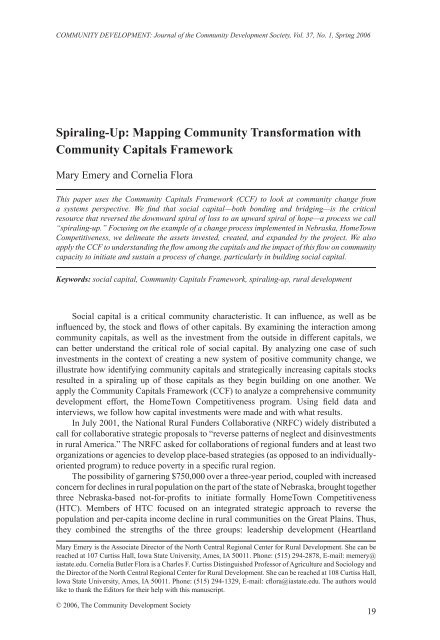

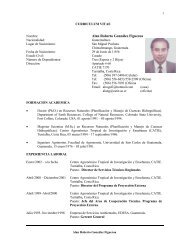
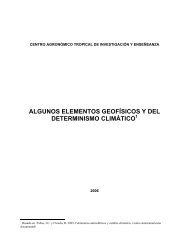
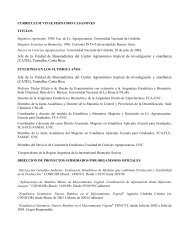
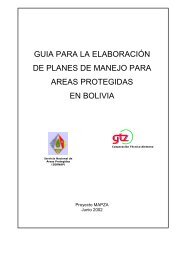
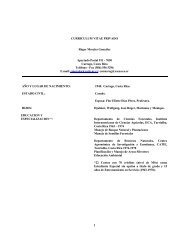
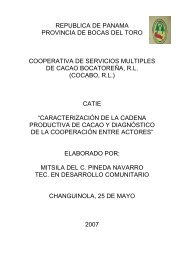

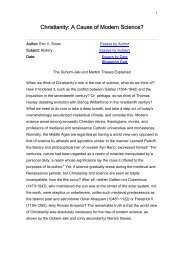

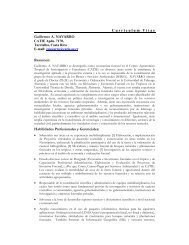

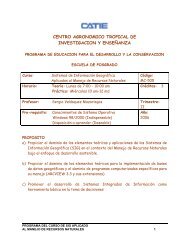
![Tratamientos y MD_2009 [Modo de compatibilidad].pdf - Catie](https://img.yumpu.com/49175499/1/190x134/tratamientos-y-md-2009-modo-de-compatibilidadpdf-catie.jpg?quality=85)